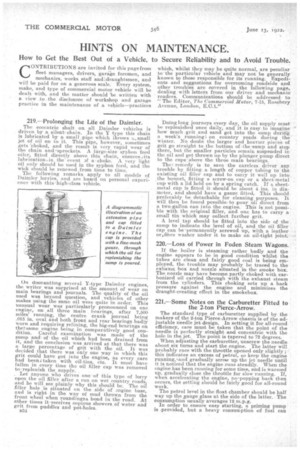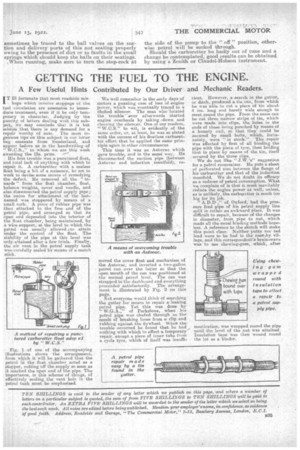219. — Prolonging the Life of the Daimler.
Page 32

Page 33

If you've noticed an error in this article please click here to report it so we can fix it.
The eccentric shaft on all Daimler vehicles is driven by a silent'ehain. In the Y type this chain is lubricated by a small .pipe which throws a.small jet of oil on to it. This pipe, however, sometimes gets 'choked, and the result is very. rapid wear of the chain and..sprockets. A large-size syphon feed oiler, fitted directly above this chain, ensures lubrication in. theevent 3f a.,..choke. A very light oil only should be used in the syphon feed, and the wick should be renewed.from time to time.
The following remarks apply to all models of Daimler lorries, and are based on personal experience with thislaig.h.-class vehicle.
On dismantling several Y-type Daimler engines, the writer was surprised at the amount of wear on main bearings and journals. The quality of the oil used was beyond question, and vehicles of other makes using the same oil were quite in order. This unusual wear was particularly pronounced on one engine, on all three main bearings, after 7,500 miles' running, the centre crank journal being .015 in. oval. and both front and rear bearings badly worn and requiring relining, the big-end hearings on thetsame engine being in comparatively good condition. Careful examination was made of the sump and'. of the oil which had been drained from it, and.the conclusion was arrived at that there was a large percentage of grit with the Oil. It was decided that there was only one way in which this grit could have got into the engine,, as every care had beenztaken with oil-tins, etc. It must have fallen in every time the oil filler tap was removed to-replenish the supply. . Let anyone who drives one ..of this type of lorry open the oil filler after a run on wet country roads. and he will see plainly why this should be. The oil Eller hole is situated on the side of engine base, and is right in the way of mud thrown from the front wheel when roundingta bend in the road. At other times it .receives copious showers, of water and grit from puddles' and pot-holes.
B34
Doing long journeys every day, the oil supply must be replenished once daily, and it is easy. to imagine how much grit and sand get into the sump during a week's running'; on country roads during :the winter. No doubt the larger and heavier pieces of grit go straight to the bottom of Ahesunip and stop there, but the smaller particles remain suspended in the oil and get thrown up by the plunger pump direct to the eups-,above the throe main bearings.
They remedy is to save the careless driver any trouble by fitting a length of copper tubing to the existing oil filler cap and to carry it well up into the bonnet, fitting a screw-on cap or a sheet-metal cup with a lid held on by a spring catch. If a sheetmetal cup is fitted it should be about 4 ins, in diameter, and should have a gauze fitted. This should preferably be detachable for cleaning purposes. It will then be found possible., to pour oii direct from a two-gallon can into the engine. This is not possi. ble with the original filler, and one has to carry a small tin which may collect further grit. A. level tap should be fitted into the side of the Bump to indicate the level of oil, and the oil filler cap can be-permanently screwed up, with a leather or,fibre washer under it to make an oil-tight joint.
220.--Loss of Power in Foden Steam Wagons.
If the boiler is steaming rather badly and the engine appears to be in good condition whilst the tubes are clean and fairly good coal is being employed, the trouble may probably be traced to the exhaust box and nozzle situated in the smoke box. The nozzle may have become partly choked with carbonized oil carried through with the exhaust steam from the cylinders. This choking sets up a back pressure against the engine and minimizes the draught-creating effect in the smokebox.
221.—Some Notes on the Carburetter Fitted to the 2-ton Pierce-Arrow.
The standard type of carburetter supplied by the makers of the 2-ton Pierce-Arrow chassis is of the adjustable needle jet design. In setting it for all-round efficiency, care must be taken that the point of the needle is perfectly straight and concentric with the hole in the jet. The point is tapered to 72 degrees.
When adjusting the carburetter, unscrew the needle. about six turns and start the engine. The latter will probably race with the throttle opened only slightly ; this indicates an excess of petrol, so keep the engine running, and gradually screw up the jet needle until it is noticed that the engine runs steadily. When the engine has been running for some time, and is warmed up, gradually close the throttle for slow running. If, when accelerating the engine, no-popping back then occurs, the setting should be fairly good for all-round -work.
The petrol level in the float chamber should be half way up the gauge glass at the side of the latter. The consumption usually averages 12 m.p.g. In order to ensure easy starting, a priming pump is provided, but a heavy consumption of fuel can
sometimes be traced to the ball valves on the suction and delivery ports of this not seating properly owing to the presence of dirt or to faults in the small springs which should keep the balls on their seatingS. ,When running, make sure to turn the stop-cock at
the side of the pump to the " off" position, otherwise petrol will be sucked through.
Should the carburetter be badly out of tune and a change be contemplated, good results can be obtained by using a Zenith or Claudel-Hobson instrument.


































